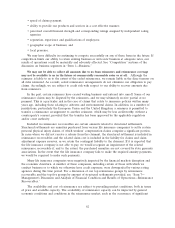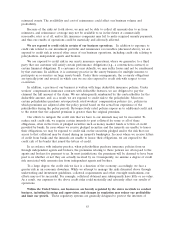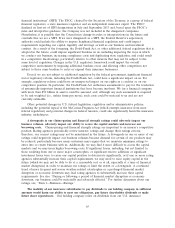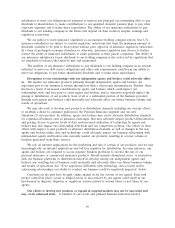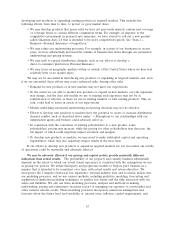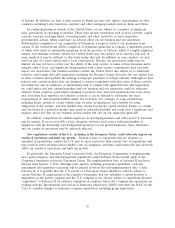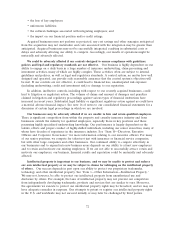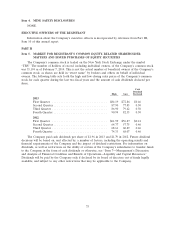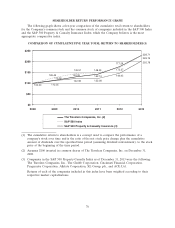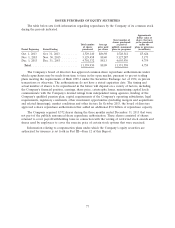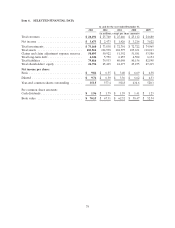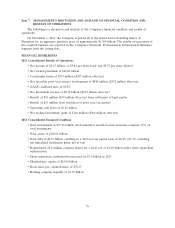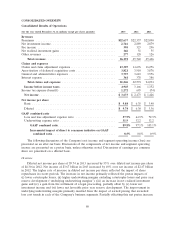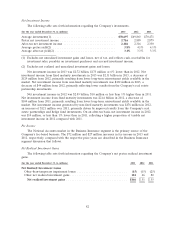Travelers 2013 Annual Report Download - page 82
Download and view the complete annual report
Please find page 82 of the 2013 Travelers annual report below. You can navigate through the pages in the report by either clicking on the pages listed below, or by using the keyword search tool below to find specific information within the annual report.• the loss of key employees;
• unforeseen liabilities;
• the cultural challenges associated with integrating employees; and
• the impact on our financial position and/or credit ratings.
Acquired businesses may not perform as projected, any cost savings and other synergies anticipated
from the acquisition may not materialize and costs associated with the integration may be greater than
anticipated. Acquired businesses may not be successfully integrated, resulting in substantial costs or
delays and adversely affecting our ability to compete. Accordingly, our results of operations might be
materially and adversely affected.
We could be adversely affected if our controls designed to ensure compliance with guidelines,
policies and legal and regulatory standards are not effective. Our business is highly dependent on our
ability to engage on a daily basis in a large number of insurance underwriting, claim processing and
investment activities, many of which are highly complex. These activities often are subject to internal
guidelines and policies, as well as legal and regulatory standards. A control system, no matter how well
designed and operated, can provide only reasonable assurance that the control system’s objectives will
be met. If our controls are not effective, it could lead to financial loss, unanticipated risk exposure
(including underwriting, credit and investment risk) or damage to our reputation.
In addition, ineffective controls, including with respect to our recently acquired businesses, could
lead to litigation or regulatory action. The volume of claims and amount of damages and penalties
claimed in litigation and regulatory proceedings against various types of financial institutions have
increased in recent years. Substantial legal liability or significant regulatory action against us could have
a material adverse financial impact. See note 16 of notes to our consolidated financial statements for a
discussion of certain legal proceedings in which we are involved.
Our businesses may be adversely affected if we are unable to hire and retain qualified employees.
There is significant competition from within the property and casualty insurance industry and from
businesses outside the industry for qualified employees, especially those in key positions and those
possessing highly specialized underwriting knowledge. Our performance is largely dependent on the
talents, efforts and proper conduct of highly-skilled individuals, including our senior executives, many of
whom have decades of experience in the insurance industry. See ‘‘Item 10—Directors, Executive
Officers and Corporate Governance’’ for more information relating to our executive officers. For many
of our senior positions, we compete for talent not just with insurance or financial service companies,
but with other large companies and other businesses. Our continued ability to compete effectively in
our businesses and to expand into new business areas depends on our ability to attract new employees
and to retain and motivate our existing employees. If we are not able to successfully attract, retain and
motivate our employees, our business, financial results and reputation could be materially and adversely
affected.
Intellectual property is important to our business, and we may be unable to protect and enforce
our own intellectual property or we may be subject to claims for infringing on the intellectual property
of others. Our success depends in part upon our ability to protect our proprietary trademarks,
technology and other intellectual property. See ‘‘Item 1—Other Information—Intellectual Property.’’
We may not, however, be able to protect our intellectual property from unauthorized use and
disclosure by others. For example, the laws of intellectual property may not prevent our competitors
from independently developing trademarks, products and services that are similar to ours. Moreover,
the agreements we execute to protect our intellectual property rights may be breached, and we may not
have adequate remedies in response. Our attempts to patent or register our intellectual property rights
in the U.S. and worldwide may not succeed initially or may later be challenged by third parties.
72


